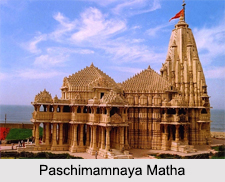 Paschimamnaya Matha is founded in 491 AD for the preservation of the ethnicity of India. This Peeth is also known by variety of names like Kalika Matha and the Western Matha. The existing head or Shankaracharya of this order is Swami Svarupananda Sarasvati, who also claims to be the head of the equivalent northern matha at Jyotirmath. It is believed that immediately after the death of Lord Krishna and the consequential downfall of the Yadav dynasty, a gigantic flood swallowed all of the Dwarka and waterlogged the city of gold to the bottom of the ocean. However, existing excavations give us reason to think this myth has a historical basis, as most myths do.
Paschimamnaya Matha is founded in 491 AD for the preservation of the ethnicity of India. This Peeth is also known by variety of names like Kalika Matha and the Western Matha. The existing head or Shankaracharya of this order is Swami Svarupananda Sarasvati, who also claims to be the head of the equivalent northern matha at Jyotirmath. It is believed that immediately after the death of Lord Krishna and the consequential downfall of the Yadav dynasty, a gigantic flood swallowed all of the Dwarka and waterlogged the city of gold to the bottom of the ocean. However, existing excavations give us reason to think this myth has a historical basis, as most myths do.
Till the year 1921, Sri Trivikrama Tirtha was the chief of the Dwaraka matha and after him Sri Bharati Krishna Tirtha succeeded him. He had a very fascinating career as Bharati Krishna Tirtha started his career as a student of Vedanta at Sringeri. After that he was initiated into sannyasin under Sri Trivikrama Tirtha of Dwaraka, and succeeded to the Sankaracharya position at `Paschimamnaya matha`, in 1921.
Colonisation of the Paschimamnaya Matha
The colonial British government pursued him along with the Ali brothers and other Muslim leaders and soon after the First World War. He was suspected with the charge that he has an association with the Indian Independence movement and he is the follower of the Khilafat movement. According to some records, he is also said to have revealed some ancient sutras of basic arithmetic, which have been published as a book, under the title "Vedic mathematics". In the year 1925, he was asked to take over the Puri matha, when that seat fell unoccupied. Sri Abhinava Saccidananda Tirtha in the year 1945 was nominated as the Shankaracharya of Dwaraka. Sri Bharati Krshna Tirtha performed the initiation ceremonies. Sri Abhinava Saccidananda Tirtha was the chief of the Mulabagal matha in Karnataka before taking over at Dwaraka. The Mulabagal matha was an old branch of the Dwaraka matha, which was established in the 17th century. After he was seated at the `pascimamnaya matha`, confirmative lineage of Mulabagal matha was amalgamated with that of Dwaraka.
Succession of Paschimamnaya Matha
To mediate the succession issues at both Puri and Jyotirmath in later years, he was called upon. The samadhi site of Adi Sankara at Kedarnath was also renovated with the initiation of him and of course with the assistance from the government of Uttar Pradesh. Sri Svarupananda Sarasvati of Jyotirmath assumed charge at Dwaraka following the death of Sri Abhinava Saccidananda Tirtha in 1982. Sri Abhinava Vidya Tirtha of Sringeri did ordinate his appointment, and Sri Svarupananda has held dual charge at both Dwaraka and Jyotirmath since then.



















